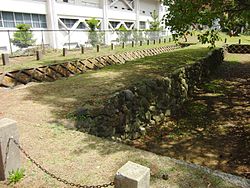Mongol invasions of Japan

Mongol invasions of Japan (元寇, Genkō) in 1274 and in 1281 were major military events in Japanese history.[1] Kublai Khan twice tried to conquer the Japanese islands; and his armies failed both times.
The two failed invasion attempts are important because they were defining events in Japanese history.[2]
The attempts show the limits of Mongol (Yuan Dynasty) ability to expand the Chinese empire.[3]
Timeline
- November 19, 1274 (Bun'ei 11, 20th day of the 10th month): Kublai Khan sent a fleet and an army to invade Japan. Some military forces landed near Fukuoka in Kyūshū; however, a storm sank many of the ships. The major part of the invading army is drowned. The invaders retreat to Korea.[4] During the brief fighting, the Hakozaki Shrine was burned to the ground.[5] This is called the Battle of Bun'ei (文永の役, Bun'ei no eki) or the "Bun'ei War".[6]
- 1281 (Kōan 4): There was a second Mongolian attempt to invade Japan. This is called the Battle of Kōan (弘安の役, Kōan no eki) or the "Kōan War".[7]
Consequences
After the destruction of the Mongol invaders, Japan's independence was guaranteed. A power struggle within Japan led to the growth of military governments and less Imperial power.[8]
Mongol Invasions Of Japan Media
Letter from Kublai Khan of the "Great Mongol State" (大蒙古國) to the "King of Japan" (日本國王), written in Classical Chinese, the lingua franca in East Asia at the time, dated 8th Month, 1266. Now stored in Tōdai-ji, Nara, Japan.
Two Samurai with a dead Mongol at their feet. The one on the right is possibly Sō Sukekuni, the defending commander at Tsushima. Votive image (ema) at the Komodahama Shrine at Sasuura on Tsushima.
A stone defense wall (Genkō Bōrui) at Nishijin, near Seinan University. Currently, only the top of a few stone walls are exposed to the ground, and most of them have been reclaimed
Japanese samurai boarding Yuan ships in 1281
Related pages
References
- ↑ Nussbaum, Louis-Frédéric. (2005). "Genkō" in Japan Encyclopedia, p. 238.
- ↑ Web Chronology Project, "Early Japan: 552-1281"; retrieved 2012-4-29.
- ↑ Cultural China (Shanghai News and Press Bureau), "Mongol invasions of Japan - Major Military Invasions Undertaken by Kublai Khan" Archived 2012-04-13 at the Wayback Machine; retrieved 2012-4-29.
- ↑ Davis, Paul K. (2001). 100 decisive battles: from ancient times to the present, p. 147.
- ↑ Turnbull, Stephen R. (2003). Genghis Khan & the Mongol Conquests 1190–1400, p. 66.[dead link]
- ↑ Nussbaum, "Bun'ei no eki" at p. 90.
- ↑ Nussbaum, "Kōan no Eki" at p. 535.
- ↑ Davis, p. 146.
Other websites
| Wikimedia Commons has media related to Lua error in Module:Commons_link at line 62: attempt to index field 'wikibase' (a nil value).. |
- Fukuoka/Hakata Tourist Information, "Historic spots of Genko (Mongol invasion of Japan)" Archived 2012-04-29 at the Wayback Machine
- Bowdoin, Mongol Invasions of Japan Archived 2011-03-02 at the Wayback Machine





